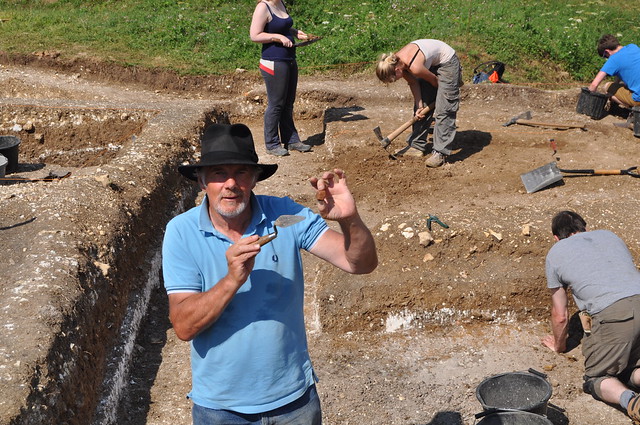Day 14 – Box Grid Excavations – by Eden
Student reporter, Eden’s blog post on what it has been like to work on a 1960′s box grid excavation with lots of sections within baulks, rather than a more modern plan excavation where the horizontal plane is significatn for interpretation.
—
A box grid excavation involves digging a series of square trenches which are separated by preserved vertical sections called baulks. The technique was originally developed by Sir Mortimer Wheeler and refined by Kathleen Kenyon.
This simple and effective method of excavation allows archaeologists to gain a good overall understanding of a site whilst being relatively economical in terms of time and energy expended. Another advantage to the box-grid excavation is that the baulks demonstrate stratigraphic changes across the site.
This allows finds to be easily associated to specific layers. This has proved particularly useful at Basing House because the site has evidence for human occupation since the Mesolithic and is situated on highly uneven ground. Consequently, having stratigraphic reference points across the site has proven useful.

Picture of stratigraphy
However, a box-grid excavation is less comprehensive than an open plan excavation. This is demonstrated by the large numbers of interesting finds which we have discovered in areas unexcavated by the Aldermaston archaeologists, and which we are beginning to discover as we excavate the baulks.
The use of the box-grid excavation has dramatically declined with the development and increased availability of more advanced surveying equipment. Such equipment allows us to accurately assess the archaeology without necessarily digging test pits. Furthermore, the increasing reliance on technology within archaeology has engendered a change in the attitudes and techniques of archaeologists throughout the archaeological process.

Dave Allen with a Roman tesserae.
One of the challenges we have faced during our excavation has been finding the edges of some of the 1960s trenches. The trenches were backfilled over a period of several years and to varying degrees. One consequence of this has been to create slumps which reduce the clarity of the baulk edges and disturb the accuracy of the stratigraphic layers. A mixture of careful troweling and a keen eye have enabled us to overcome these problems.
Going into our final week we aim to continue excavating the baulks. This will allow us to consolidate the work of the Aldermaston Archaeological Society and hopefully it will enable us to reinterpret the site more accurately.
Filed under: Day Fourteen, Student Reporter Tagged: aldermaston, baulk, box grid, kathleen kenyon, mortimer wheeler, stratigraphy
